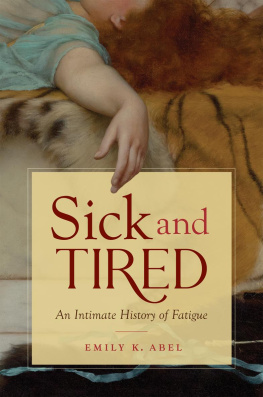After the Cure
After the Cure
The Untold Stories of Breast Cancer Survivors
Emily K. Abel and Saskia Subramanian
Foreword by Patricia A. Ganz
NEW YORK UNIVERSITY PRESS
New York and London
www.nyupress.org
2008 by New York University
All rights reserved
Library of Congress Cataloging-in-Publication Data
Abel, Emily K.
After the cure : the untold stories of breast cancer survivors /
Emily K. Abel and Saskia K. Subramanian.
p. cm.
Includes bibliographical references and index.
ISBN13: 9780814707258 (cl : alk. paper)
ISBN10: 0814707254 (cl : alk. paper)
1. BreastCancerTreatmentComplications. 2. BreastCancerPsychological
aspects. 3. Antineoplastic agentsSide effects. I. Subramanian, Saskia K. II. Title.
RC280.B8A22 2008
616.99449061dc22 2008020941
New York University Press books are printed on acid-free paper, and their binding materials are chosen for strength and durability. We strive to use environmentally responsible suppliers and materials to the greatest extent possible in publishing our books.
Manufactured in the United States of America
c 10 9 8 7 6 5 4 3 2 1
p 10 9 8 7 6 5 4 3 2 1
Contents
Acknowledgments
FIRST AND FOREMOST , we thank the women who opened their homes and their lives to us. The courage and thoughtfulness they demonstrated at every turn were humbling. The generous support from the Susan G. Komen Foundation also was critical to this study.
Rebecca Crane-Okada provided enormous assistance while we were developing and conducting the research. Other key members of the research team included Jean Cadigan, Judy Olweny, and Lotte Thomsen, as well as project managers Teresa Magula, Ana Johnson, and Kiavash Nikkhou. Many students completed the least glamorous but most crucial jobs such as data entry, coding, transcribing, and photocopying literature. Most notable for their longevity with the project are Nelli Boykoff, Kristina Contreras, Jennifer Johnson, Nicole Lee, Tasneem Motala, Georgia Scheele, and Jared Wong.
Rick Abel, Kathy Davis, Patricia Ganz, Janet Golden, Ilene Kalish, Rose Weitz, and two anonymous reviewers read the manuscript and offered wonderfully helpful advice. Margaret K. Nelson provided ongoing assistance about sociological methods.
Saskia also thanks her research mentor, M. Belinda Tucker, for providing guidance during this study. Saskias late mother, Cornelia Termeulen, offered valuable assistance in crafting the Komen grant application, as well as loving moral and intellectual support. Her husband, Marcus Linden, proved a superb sounding board and was of great help at a number of junctures during the project.
Emily Abel thanks four doctors who provided models of care and compassion, Nancy Feldman, Patricia Ganz, Lois Schwartz, and Susan Stangl, as well as the many family and friends who offered crucial support both during cancer treatment and beyond.
Foreword
DURING THE SPAN of my career in medicine, breast cancer has been transformed from a disease that was hidden from family and friends to one that has a public face with a strong advocacy movement. Most women and men have familiarity with the diagnosis and treatment of breast cancer based on frequent newspaper and magazine articles, including descriptions of the medical treatment of high-profile celebrities and public figures. Less well-known are some of the difficulties faced by women who have been treated for breast cancer. In this volume, the authors provide an in-depth exploration of the symptoms experienced by some women after breast cancer treatment, giving voice to a neglected aspect of the breast cancer experience. As Drs. Abel and Subramanian point out in their introduction, breast cancer is now a chronic disease (as are most other cancers after curative intent treatment), mostly due to the success of multimodal therapies that may lead to long-term persistent symptoms. In addition, the fear of distant recurrence and the required surveillance for second cancers in the breast heighten a womans anxiety and increase awareness of her vulnerability. Life was much simpler in some ways for the breast cancer patient fifty years ago, when after a radical mastectomy, she was told by her surgeon, I got it all! In fact, the survival rate then was about half what it is today.
There is certainly a high price to pay for increased survival resulting from contemporary cancer therapy. Breast cancer treatments are complex, toxic, and costly, and they take many months to complete. There is a toll on families and relationships during this time, and when treatment ends, the woman is faced (often alone) with putting her life back on track. Family members, friends, and the medical staff may wish to celebrate the milestone of the completion of treatment, but the breast cancer patient knows that for her, life will never be the same. Nevertheless, many women are extremely resilient in the face of this challenge and manage to get through this transition with a limited number of persistent symptoms and a new appreciation for life that was not always there before. In fact, for most women, symptoms gradually abate, energy levels recover, and new hair returns on the scalp. About a year after treatment ends, many women feel that they are back to most of their pre-illness physical activities. Specific groups for whom this is generally not true are those who are pushed into permanent menopause as a result of chemotherapy and those who require extensive and more disfiguring surgery (with or without reconstruction). The more intensive the therapy, however, the more likely a woman may be to suffer from fatigue, cognitive complaints, pain, and insomnia. This was dramatically seen in the women who underwent high-dose chemotherapy with bone marrow rescue during the early 1990s. Fortunately, such therapy is seldom given anymore as a result of its lack of efficacy, but current standard adjuvant chemotherapy is often much more intense than what was given a decade ago because supportive therapies (red and white cell growth factors) permit its use.
Today, for many women mammographic screening detects small breast tumors, which are treated with more limited breast surgery and removal of only a few lymph nodes from under the arm. The morbidity of this treatment is very modest, although follow-up breast radiation and endocrine therapy may cause problems for some women. Use of new genetic profiling tests in these instances can spare women toxic chemotherapy if it is unlikely to be helpful. However, how and why some women suffer persistent symptoms, and others do not, is an active area of research and investigation. This book calls important attention to the plight of these women, examining the struggles they face in having health care professionals, family members, and co-workers understand their experience and the impact of symptoms on their ability to function.
What can a woman with persistent and debilitating symptoms do under these circumstances? Must she suffer in silence, like many women described in this volume? The clear message from Abel and Subramanian is no. Bringing these ongoing problems out into the open gives them validity and is supportive to other women with symptoms after breast cancer who may read this book. The use of qualitative methods and the direct quotations from these breast cancer survivors enriches the book and provides an opportunity to identify with aspects of each womans experience. Health care providers who read this book will develop a better appreciation for the need to attend to the ongoing symptoms of breast cancer survivors, as the consequences of neglect are many, as noted by the authors. For example, extended use of adjuvant endocrine therapy, especially the widely used aromatase inhibitors, is responsible for moderately severe ongoing symptoms in many breast cancer survivors. Failure to address these symptoms leads to diminished adherence to treatment, cheating women of the therapeutic benefit of highly effective therapy.











